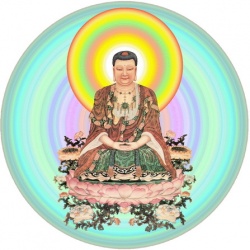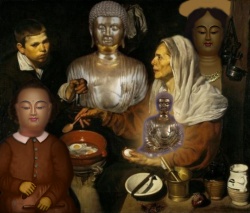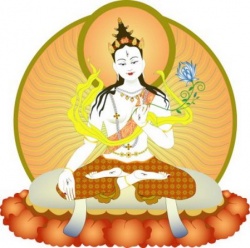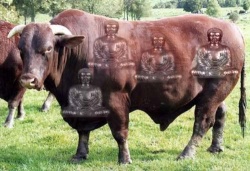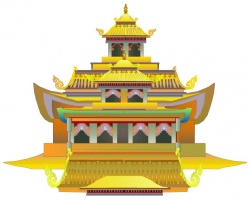The Mahayana Model of Awakening
About 400 years after the passing away of Shakyamuni Buddha, i.e. around 1 century BCE, the school of Mahayana Buddhism developed with a different emphasis and focus of practice as compared to the practitioners of Early Buddhism (Also see: Early Buddhism's Model of Awakening). Examples of forms of Mahayana Buddhism practiced today include Zen, Pure Land, Tantric/Vajrayana (including Tibetan, Japanese Shingon), Tendai, and a number of others schools that no longer exist today or are absorbed into Zen (e.g. Huayan). Today, the number adherents of the Mahayana forms of Buddhism in the world have exceeded the number of adherents of the Theravada/Early form of Buddhism due to the extent in which Mahayana forms of Buddhism have spread into China, Japan and Tibet.
The practitioners of Early Buddhism (of which Theravada is modeled after), or what Loppon Malcolm calls "Mainstream Buddhism" (because it was a much more commonly practiced form of Buddhism in the past in India), aimed to attain their own liberation or Nirvana by removing the afflictions (passion, aggression and delusion) that causes rebirth. Thousands of Buddha's students attained that goal called Arahantship.
However, Mahayana Buddhism has a higher aim. Not only do they want to remove the causes for samsaric birth, they also want to remove all knowledge obscurations preventing the attainment of omniscience and Buddhahood, for the sake of liberating all sentient beings. Mahayana Buddhists feel that the scope of attaining liberation for oneself is too limited, so out of great compassion and for the benefit of all sentient beings, they want to attain the same Buddhahood as Shakyamuni. The practitioner walking the path to Buddhahood is called a Bodhisattva.
This post attempts to share the model of awakening in classical Mahayana Buddhism. There are 10 stages of an awakened Bodhisattva, beginning with the direct realization of twofold emptiness. (The Tibetan/Vajrayana traditions may also add a few more stages, making it 13 or 16)
From a writing I wrote:
...The reason I said Bernie is a 'real bodhisattva' is not because of impressive sounding words he spoke but rather that he clearly actualizes and expresses his wisdom in compassionate activities. He is tremendously involved in compassionate and selfless activities empty of self and in total exertion. He is able to apply his wisdom of anatta and D.O. to dissolve I/mine making in the practice of paramitas in his encounters with sentient beings, which as Thusness said is the 'great anatta'
(Thusness two weeks ago: "...anatta in the 6 paramitas...it is great actualization of anatta."). For most of us, although we may have this and that Bodhisattva vows or believe ourselves to be practicing the Bodhisattva way, it is as Thusness said, "In my opinion many of our great aspirations and high views turn empty talks easily...." - http://awakeningtoreality.blogspot.com.au/.../the-path-of... - or like my Mahayana teacher said, even the greatest vow becomes merely a discursive/fanciful thought when not actualized....
...The practice and engagement of the 10 paramitas (or 6) in the daily life becomes of utmost importance in Mahayana Buddhism, allowing the twofold cultivation of merits and wisdom so necessary for the attainment of full Buddhahood. It is in fact in the very mundane activities of daily life and interactions that allows us the opportunity to attain the ten perfections (paramitas) that allows us to attain full Buddhahood. The paramitas are not just 'mundane qualities', but the actualization of awakened wisdom - for example, the perfection of generosity is not just the ability to give lots of money to other people, but rather, the selfless giving freed from any confusion of a giver-giving-gift.
The wisdom of the emptiness of self and phenomena allows our act of generosity to be perfected. When our giving transcends giver-giving-gift, without attachments we relinquish and give and sacrifice for other beings out of genuine compassion, that is true generosity. The cultivation of the ten paramitas in conjunction of the wisdom of emptiness is itself a method for the liberation of our mental afflictions, clinging, I and mine-making, as well as the cultivation of immense merits required for Buddhahood.
It is said that at each of the ten bhumi stages, one of the perfections have been perfected. For example, the first bhumi perfects the perfection of generosity, second bhumi the perfection of precepts, so on and so forth.
In short, in the Mahayana path, as Huayan Patriarch Cheng'guan explained ( http://awakeningtoreality.blogspot.com.au/.../httpssites... ), the essential wisdom that allows for the twofold liberation of afflictive obscurations and knowledge obscurations is the wisdom of twofold emptiness. Then there is the emphasis on cultivating the paramitas.
I translated an excerpt from 法语缤纷(2) by Venerable Shen Kai (my refuge Master) on the Mahayana Ten Bhumi Model of Awakening. Bhumi means 'Ground'.
1. The Joyous Ground: The Bodhisattva's initial entrance into sainthood, breaking through the confusion of views, realizing the principle of twofold emptiness of person and dharma. (The Bodhisattva) gives rise to great joy, therefore it is called The Joyous Ground. At this ground, (one) accomplishes the Paramita of Dana (generosity) among the Bodhisattva Ten Paramitas.
Commentary: View-Confusion - the various forms of delusional and deviant views, extreme views (e.g. eternalism/nihilism, existence/non-existence), self views, etc.
Dana - Generosity, has the meaning of 'relinquishment'.
Paramita - has the meaning of 'to the other shore'.
(Chinese: 一、欢喜地:为菩萨初得圣性,破见惑,证人法二空之理,生大欢喜,故名欢喜地。于此地成就菩萨十波罗蜜中之檀波罗蜜。(注:见惑──种种妄见、邪见、边见、我见等之妄惑。檀──布施,即舍义。波罗蜜──乃到彼岸的意思。) )
2. The Stainless Ground: accomplishes the Paramita of Precepts among the Ten Paramitas, eliminating (comments: more accurately, 'attenuating' in this case) the confusion of practice, removing the stain of immorality/precepts-breaking, resulting in purity of mind and body, therefore known as The Stainless Ground.
Commentary: Confusion of practice -- also known as the confusion of thoughts. Due to practicing the Path, (one is able to) terminate passion, aggression and delusion, and other various confusion of strong afflictive emotions.
(Chinese: 二、离垢地:成就十波罗蜜中之戒波罗蜜,断修惑,除毁犯之垢,使身心清净,故名离垢地。(注:修惑──即思惑,因修道而断贪瞋痴等迷情之惑。) )
3. The Luminous Ground: Accomplishes the Paramita of Patience among the Ten Paramitas, eliminating (i.e. attenuating) the confusion of practice, attaining the Paramita of Contemplation. Wisdom reveals and manifests, therefore it is known as the Luminous Ground.
Commentary: The Paramita of Contemplation - also known as the patience of the non-arising of dharma, also known as the non-rising patience, contemplating on the Truth and thereby resting in (the equipoise/knowledge of) non-arising.
(Chinese: 三、发光地:成就十波罗蜜中之忍辱波罗蜜,断修惑,得谛察法忍,智慧显发,故曰发光地。(注:谛察法忍──即无生法忍,或名不起忍,察观真理而安住于无生者。) )
4. The Glowing Wisdom Ground: Accomplishes the Paramita of Effort/Exertion/Diligence/Energy/Vigour, eliminating (i.e. attenuating) the confusion of practice, resulting in the blazing forth of wisdom, therefore it is known as the Glowing Wisdom ground.
(Chinese: 四、焰慧地:成就十波罗蜜中之精进波罗蜜,断修惑,使慧性炽盛,故云焰慧地。 )5. The Difficult to Prevail Ground: accomplishes the Dhyana Paramita of the Ten Paramitas, eliminates (i.e. attenuates) the confusion of practice, integrating the twofold wisdom of the ultimate and conventional into seamless fitting, therefore it is known as the Difficult to Prevail Ground.
(Chinese: 五、极难胜地:成就十波罗蜜中之禅波罗蜜,断修惑,真俗二智之行互违者,使之合而相应,故为极难胜地。 )
6. The Manifest Ground: accomplishes the Prajna Paramita among the Ten Paramitas, eliminating (i.e. attenuating) the confusion of practice, manifesting the utmost prevailing/supreme wisdom, leading to the manifestation/revelation of the absence of the distinctions of impurity and purity, therefore it is known as The Manifest Ground.
(Chinese: 六、现前地:成就十波罗蜜中之般若波罗蜜,断修惑,发最胜智,使现前无染净之差别,故谓现前地。 )
7. The Gone Afar Ground: accomplishes the Paramita of Skillful Means among the Ten Paramitas, giving rise to the heart of Great Compassion, eliminating (i.e. attenuating) the confusion of practice, leaving far behind the self-release of the two vehicles (Sravakayana and Praytekabuddhayana), therefore it is known as the Gone Afar Ground.
(Chinese: 七、远行地:成就十波罗蜜中之方便波罗蜜,发大悲心,亦断修惑,远离二乘之自度,故称远行地。)
8. The Immovable Ground: accomplishes the Paramita of Vow among the Ten Paramitas, eliminating the confusion of practice, engages in the contemplation of signlessness, 任运无功用相续 (not sure how to translate this), therefore it is known as the Immovable Ground.
(Chinese: 八、不动地:成就十波罗蜜中之愿波罗蜜,断修惑,作无相观,任运无功用相续,故为不动地。)
9. The Virtuous Wisdom Ground: accomplishes the Paramita of Strength among the Ten paramitas, eliminating the confusion of practice, endowed with the Ten Powers, everywhere (one) is able to know whether (the sentient being) can be saved/released or not released, (one) is able to preach the dharma, therefore it is known as the Virtuous Wisdom Ground.
(Chinese: 九、善慧地:成就十波罗蜜中之力波罗蜜,断修惑,具足十力,于一切处知可度不可度,能说法,故谓之善慧地。)
10. The Dharma Cloud Ground: accomplishes the Wisdom Paramita among the Ten Paramitas, eliminating the confusion of practice, endowed with limitless merits, giving birth to the water of limitless merits, like a great cloud covering the empty sky, is capable of pouring down all kinds of pure dew and dharma rain, nourishing sentient beings, therefore it is known as the Dharma Cloud Ground.
(Chinese: 十、法云地:成就十波罗蜜中之智波罗蜜,亦断修惑,具足无边功德,出生无边功德水,如大云覆虚空,能降清净之一切甘露法雨,普润群生,故云法云地。)
After the 10th bhumi, there is two more levels, known as 等觉 (equal awakening) and 妙觉 (marvellous awakening).
The Bodhisattva at 等觉 level is almost equivalent to 妙觉 and is awaiting the chance to descend from the Tushita Heaven to become the next Buddha. An example would be the current Maitreya Bodhisattva.
MSK:
等是平等相等,觉是觉悟,在此,第五十一位之菩萨,其觉悟等同
诸佛,是菩萨之最高极位,其修行已满三大阿僧只劫,将得妙觉之佛果,其智慧功
德,等似妙觉,惟至妙觉,尚差一等,故谓之等觉。等觉菩萨,又名为一生补处菩
萨,如现在兜率陀天弥勒内院的弥勒菩萨,就是一生补处的等觉大菩萨,人尊称为
当来下生弥勒尊佛,再过五十六亿七千万年,他即降生到地球娑婆世界的人间成佛
,接替释迦牟尼佛的佛位。
所谓“妙觉”者?妙觉即佛果之无上正等正觉,因佛乃菩萨修行而成,虽然成佛,
亦列于菩萨位次的第五十二位—最高位。小乘止于自觉,无觉他之功,大乘菩萨,
自觉觉他并行,而未圆满,唯独有佛自觉觉他,觉行圆满究竟,神通妙用,不可思
议,故名为妙觉,十地以上,皆入圣位,十地与等觉,乃妙觉之因行,妙觉乃十地
与等觉之果位,此乃是菩萨所修十度万行最后所得的佛果。
